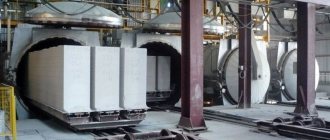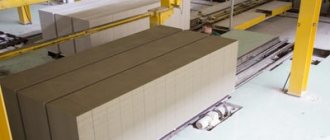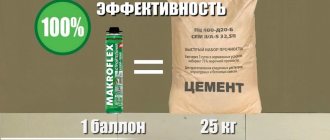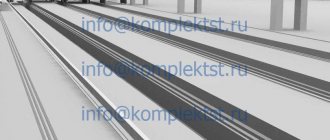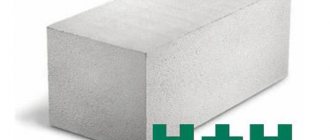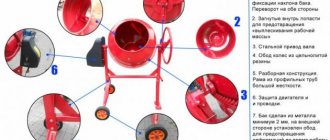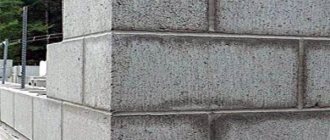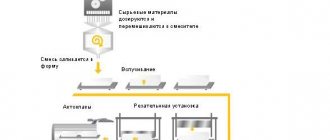Production of aerated concrete blocks
Not so long ago, the production of a popular material in the form of building stone was possible only in a factory. But with the improvement of technology, such an opportunity has appeared not only for small entrepreneurs, but also for the developers themselves.
At the moment, there is a large number of different equipment designed for the production of this representative of cellular concrete. The sets differ from each other in a number of ways, primarily in price category and production volume.
In this article we will consider equipment for the production of aerated concrete blocks of various types, and analyze the process of manufacturing the products itself. We will also compare material produced at home and in a factory.
General technology for the production of aerated concrete
First, perhaps, let’s consider the general principle of the technological process. Indeed, for a full overview of the equipment lines, we need to have an idea of how exactly the aerated concrete block is made.
Necessary raw materials
To prepare an aerated concrete mixture, you will need the following raw materials:
- Cement grade no less than M400;
- Water;
- Quicklime;
- Gypsum;
- Quartz sand;
- Aluminum powder.
Aluminum powder
It also doesn’t hurt to add a plasticizer to the solution. Its main purpose is to increase the plasticity of the solution, which prevents cracking of products at the drying and hardening stage.
Plasticizer
Other chemical additives are also used. As a rule, they are added to improve the quality of finished products.
Proportions of raw materials with additives
Note! The above composition is classic. Many components can be replaced. In this case, the set of numeric property values will also vary.
- The siliceous component can be presented in the form of: sand, ash and other secondary industrial products;
- The type of binder can also be different: cement, slag, lime, mixed, ash.
The approximate content of the proportions is as follows:
- 50-60% - cement;
- 20-40% - sand;
- 1-10% - lime;
- Up to 1% - water.
On a note! If you want to increase the density of products, you should increase the amount of cement. In this case, the mass of the finished material and the thermal conductivity coefficient will also change.
Proportions depending on the desired density
Main stages
Brief instructions look like this:
- First of all, the components are weighed and mixed in the required proportions. When making it yourself, this is done manually, in a factory environment, usually in automatic mode.
- All ingredients go into the mixer, where mixing occurs.
- The next step will be molding. The molds are filled approximately 1/3 full, since when pores form, the mixture can simply leak out.
- Next, after completing the swelling process, wait some time until it partially hardens.
- Next, a single layer is cut or simply stripped if the forms are used in ready-made standard sizes.
- The last step will be autoclaving or sending the blocks for drying using a non-autoclave production method.
Note! The process may differ slightly depending on what equipment is used for the production of aerated concrete blocks. However, in general, the general principle will be the same.
How much can you earn by producing aerated concrete blocks?
How much profit can the production of aerated concrete bring? Here are some brief economic indicators.
Cost of 1 cubic meter meter of aerated concrete will be about 1,500 rubles. It consists of the costs of cement (250 kg - 1000 rubles), sand (300 kg - 180 rubles), aluminum powder and chemical additives (150 rubles), labor and overhead costs (150 rubles) In Russia, aerated concrete sells for at least 2500 rubles. for 1 cubic meter. Accordingly, your minimum profit will be 1000 rubles. and more. Another advantage of this business is that it does not require large working capital, since from the time of purchasing raw materials to the sale of finished products, no more than 2-3 days can pass.
Types of installations and lines
Now let's move on to a review of equipment types.
Conveyor type
Conveyor-type aerated concrete equipment is different:
- Maximum automation of production;
- Minimal participation of workers;
- High cost;
- Large production volumes;
- Fully equipped;
- And, as a rule, the greatest profitability.
Large conveyor line
Let's take a closer look at the configuration and capabilities of such aerated concrete equipment using the example of a line from a popular Chinese manufacturer, which is a dealer of the Premium Brick Plus company.
The standard kit includes:
- Tanks and bunkers for raw materials;
Bunker for raw materials
- Belt conveyors for transporting components;
Belt Conveyor
- Mortar mixing unit;
Concrete-mortar unit
- Autoclaves;
Autoclaves
- Forms;
Prefabricated mold for blocks
- Cutting complex;
- Mixing conveyor;
- Crushers;
- Trolleys;
- Unit for automatic line control;
- Forklift.
Alternatively, you may want to consider purchasing a used conveyor line. This is a kind of risk, but its cost is much lower.
It is also worth paying attention to the mini conveyor line “Inntech-100”. Its productivity is significantly lower and amounts to 100 m3 per day. Its price is about 3,000,000.
Mini conveyor line
This line is characterized by a fixed mixer. The molds move along a rail conveyor like a cart. The components are supplied and dosed automatically. The cutting complex is mechanical.
The lines of well-known German equipment manufacturers are most valued among manufacturers. They are characterized by high productivity and durability in use. With their help, you can produce blocks of the highest quality.
German equipment for the production of aerated concrete blocks
The video in this article will demonstrate the operating principle of equipment for the production of aerated concrete.
Production of aerated concrete Porevit
Stationary type
- This type of equipment is much less expensive. However, its productivity is much lower and amounts to about 50 m3 per day.
- As a rule, such lines include component dispensers and a conveyor belt, which supplies the ingredients to the mixer.
- However, such a kit can no longer be called fully automated. For full-fledged work, at least several people are required.
- The required square footage for locating production and warehouse is about 500 m2.
Stationary line for the production of aerated concrete blocks
As an example, let us briefly consider the configuration and capabilities of the ASM-1MS line.
- Capacity is about 60 m3;
- The work will require the involvement of 3-4 people;
- Sand and cement are supplied automatically.
Equipment:
- Mixer for binder and other components;
- Design for cutting block solids with saws;
- Forms and pallets;
- Conveyor.
Mobile units and mini lines
Such equipment for the production of aerated concrete blocks is ideal for beginning entrepreneurs or developers who want to produce products for their own needs.
Using a mobile installation, it is possible to produce only non-autoclaved aerated concrete blocks. Below we will look at its main differences from its main competitor.
Such equipment requires a 220 W network, while other types of machines require a 360 W network connection. The production volume is about 2-10 m3 per day.
Mobile installation for the production of aerated concrete
Let's look at the characteristics of the installation using the example of the Aerated Concrete 500B kit.
Installation of aerated concrete 500 B
- The kit includes: mixer, connecting hoses and compressor. Production requires the participation of several people.
- Almost the entire work process involves human participation. In automatic mode, only mixing is performed.
- You will also have to do the dosing yourself.
- The output volume is 3 m3 of porous mixture.
- Mixing capacity - 500 liters.
Mini lines are more productive. With their help, it is possible to produce up to 25 m3 per day. For small entrepreneurs, this is a great option to start your own business.
The principle of their design is similar to mobile installations, but the power and volume of the mixer are greater.
Recruitment
To start a business producing aerated concrete, four employees working in shifts are enough. Organize work in day and night shifts - this will increase production and you will accept the maximum number of orders. Working in this mode, your business will quickly take off.
Employees must have work experience or specialized education. Each team member must know the technology for manufacturing aerated blocks. By hiring professionals, you minimize the risks associated with production.
To do your bookkeeping, hire an outsourced accountant. The salary of such an employee will cost on average 5,000 rubles.
More about autoclaving
Now let's talk in more detail about the autoclave processing of aerated blocks and figure out what the main differences are between self-produced products and material produced in a factory.
What is autoclaving?
With the help of autoclave processing it is possible to improve the quality of finished products.
- The blocks, cut into standard sizes, are placed in an autoclave and processed under above-atmospheric pressure with water vapor, while high temperature prevails.
- Treatment lasts for 12 hours.
- Upon completion of processing, the blocks can almost immediately be used in construction, because they have already achieved brand strength.
- A non-autoclave gains strength within 4 weeks.
- Autoclave processing improves qualities such as strength, density, and durability. Products become less fragile
It is worth noting that the production of autoclave hardening blocks is possible only in factory conditions.
Autoclaving process
Comparison of autoclave and non-autoclave gas block
Now let’s compare the properties of autoclaved aerated concrete and products that achieve strength in a natural way.
| Characteristic | Comparative analysis |
| Due to specialized processing in an autoclave, synthetic hardening products are distinguished by the best combination of density and thermal conductivity. |
| In accordance with GOST, the frost resistance grade requirements for a non-autoclave block are somewhat lower. The exact durability of both products has not been established experimentally, due to the insufficient time of existence of the material on the building materials market. |
| The autoclave has almost ideal geometry. A non-autoclave unit made at home is seriously inferior to it in this regard. |
| Equipment for autoclaved aerated concrete, in general, differs only in the presence of autoclaves. The production technology is similar, the order is the same. |
| Non-autoclave blocks are more vulnerable to mechanical stress and are more fragile. |
| Autoclave products are about 10% more expensive. |
| Non-autoclaved blocks are more susceptible to shrinkage. The indicator is up to 1 mm/m2. |
How to advertise a business
The following promotion channels are suitable for this business:
- Announcement of services. Create an informative sales ad and post it on special websites
- Bright informative banner. Place several banners along the way to holiday villages to attract attention
- Flyers and leaflets. Distribute promotional materials in construction stores, attach them to bulletin boards in gardening centers, tell them about your benefits
- Create a website with a simple design, indicate services, prices and contact information.
We showed that starting your own business is not so difficult if you understand the nuances. Decide on production volumes and launch your business!
Search for clients
Manufacturers and buyers are pleased with the fact that the building material is suitable for any climate zone. It is usually used when constructing buildings:
- low-rise residential premises;
- industrial;
- agrarian;
- administrative;
- social.
The product is in demand both among large construction organizations and individuals with development rights.
You can sell goods to construction trade warehouses and markets. Distribute price catalogs to stores. Send business proposals to development companies. Publish advertisements for private clients.
Please note that the demand for this category of product is seasonal; advertising must be organized before the start of activity. Consider the efficiency of the equipment in use and the method of creating aerated concrete - it can be put on sale a month from the date of production.
Main results
Home production of aerated concrete blocks has become widespread due to the simplicity of the technology, minimal equipment costs and real savings. Despite the lower quality indicators, the popularity of the method does not lose its relevance. The numerical values of the characteristics of the finished products are quite sufficient for the construction of a strong and durable structure.
Therefore, if the production of aerated concrete blocks at home attracts you, feel free to get to work. The result may meet all your expectations.
Possible income level
Income depends on productivity. You may have 3 predicted development options: pessimistic, realistic, optimistic.
With option 1 (loading power - 30%), your earnings are 331,200 rubles per month:
| 18 m cubic | aerated concrete daily |
| 23 | shifts per month |
| 1 242 000 | net income |
| 414 m cubic | produced monthly |
| 3,000 rubles | unit price |
| 1 year | project payback period |
Option 2 (loading power - 60%) assumes an income of 662,400 rubles per month:
| 36 m cubic | aerated concrete daily |
| 23 | shifts per month |
| 2 484 000 | net income |
| 828 m cubic | produced monthly |
| 3,000 rubles | unit price |
| Six months | project payback period |
Option 3 (load capacity – 90%) gives a profit of 993,000 rubles per month:
| 54 m cubic | aerated concrete daily |
| 23 | shifts per month |
| 3 726 000 | net income |
| 1,242 cubic meters | produced monthly |
| 3,000 rubles | unit price |
| 4 months | project payback period |
Productivity depends on you. Also influenced by the fact that the demand for this product is seasonal. It is advisable to launch production during this period and have time to sell all the goods.

